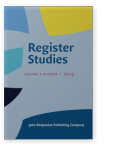Vol. 5:1 (2023) ► pp.52–81
The concept of register in heritage language retention
This paper argues for a greater consideration of the role of register in the retention of heritage languages by analyzing data on adolescent heritage-language speakers in Germany. The study addresses the following question: Which language external factors have the greatest impact on heritage-language retention in the intimate vs formal registers? A questionnaire was filled out by 202 students (age 15–17) in an urban area in Germany, who are all heritage-language speakers of 42 different languages. The major finding of this study is that heritage-language retention is determined by different language-external factors in each register. The fact that different models of heritage-language retention can be postulated for different language registers emphasizes the need to describe the language competences of heritage-language speakers according to registers.
Article outline
- 1.Introduction
- 2.Heritage languages and their speakers
- 3.The concept of register in heritage language research
- 4.The study
- 4.1Participants
- 4.2Instruments
- 4.3Results
- 4.4Discussion
- 5.Conclusion
- Acknowledgement
- Notes
-
References
For any use beyond this license, please contact the publisher at [email protected].
